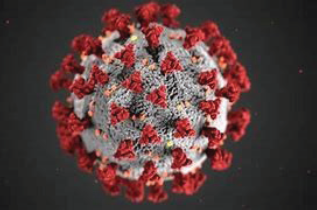Understanding the COVID-19 Vaccine
By Dr. Samir Jamil
Most people have heard of DNA (deoxyribonucleic acid), the molecule SARSCoV- 2 viral spike that creates our unique genetic code, and some may even have heard of RNA (ribonucleic acid). They are sometimes called “messenger genes;” they carry information between cells and also carry the genetic information of many viruses.
Coronaviruses are enveloped RNA viruses. The spikes projecting out from their surface gave them the name “coronavirus.” (“Corona” means “crown). The structure of SARS-CoV-2, the virus that causes COVID-19 illness, has a unique feature that could explain why it is so transmissible between people. A scientific study identified a structural loop in the SARSCoV- 2 spike protein, the area of the virus that facilitates entry into a human cell, and a sequence of four amino acids in this loop.
To understand how vaccines work, it helps to first look at how our bodies fight illness. When germs, such as the virus that causes COVID- 19, invade our bodies, they attack and multiply. This invasion, called an infection, is what causes illness.
Our immune system uses several tools to fight infection. Blood contains red cells, which carry oxygen to tissues and organs, and white or immune cells, which fight infection. Different types of white blood cells fight infection in different ways. The first time a person is infected with the virus that causes COVID-19, it can take several days or weeks for their body to make and use all the germ-fighting tools needed to get over the infection.
After the infection, the person’s immune system remembers what it learned about how to protect the body against that disease. The body keeps a few T-lymphocytes called memory cells that go into action quickly if the body encounters the same virus again.
When the familiar antigens are detected, B-lymphocytes produce antibodies to attack them.
How COVID-19 Vaccines Work
COVID-19 vaccines help our bodies develop immunity to the COVID- 19 virus without us having to get the illness. Different types of vaccines work in different ways to offer protection, but all types of vaccines will result in the body having a supply of “memory” T-lymphocytes as well as B-lymphocytes that will remember how to fight this virus in the future.
It will take a few weeks for the body to produce adequate T-lymphocytes and B-lymphocytes after vaccination. Most vaccines use two shots separated by 3-4 weeks. It is possible that a person could be infected with the virus that causes COVID-19 just before or after vaccination. They would then get sick because the vaccine did not have enough time to provide protection.
Sometimes after a vaccination, the process of building immunity can cause symptoms, such as fever. These symptoms are normal and are a sign that the body is building immunity
Types of Vaccines
Currently, there are three main types of COVID-19 vaccines that either are or soon will be available in the United States: mRNA vaccines contain material from the virus that causes COVID-19 which gives our cells instructions on how to make a harmless protein that is unique to the virus (spike protein). After our cells make copies of the protein, they destroy the genetic material from the vaccine.
Protein subunit vaccines include harmless pieces (proteins) of the virus that cause COVID-19 instead of the entire virus. Vector vaccines contain a weakened version of a live virus (a different virus than the one that causes COVID-19) that has genetic material from the virus that causes COVID- 19 inserted in it (this is called a viral vector). Once the viral vector is inside our cells, the genetic material gives cells instructions to make a protein that is unique to the virus that causes COVID-19. Using these instructions, our cells make copies of the protein
All three types of vaccine cause our bodies to recognize that the protein SARS-CoV-2 viral spike should not be there so your body builds T-lymphocytes and B-lymphocytes that will remember how to fight the virus that causes COVID-19 if we are infected in the future.
Getting vaccinated is one of many steps you can take to protect yourself and others from COVID- 19. Protection is critically important because as we know, for some people this virus can cause severe illness or death.
Vaccines work with your immune system so your body will be ready to fight the virus if you are later exposed. Other steps like wearing masks and social distancing help reduce your chance of being exposed to the virus or spreading it to others.
Stopping a pandemic requires using all the tools available.

